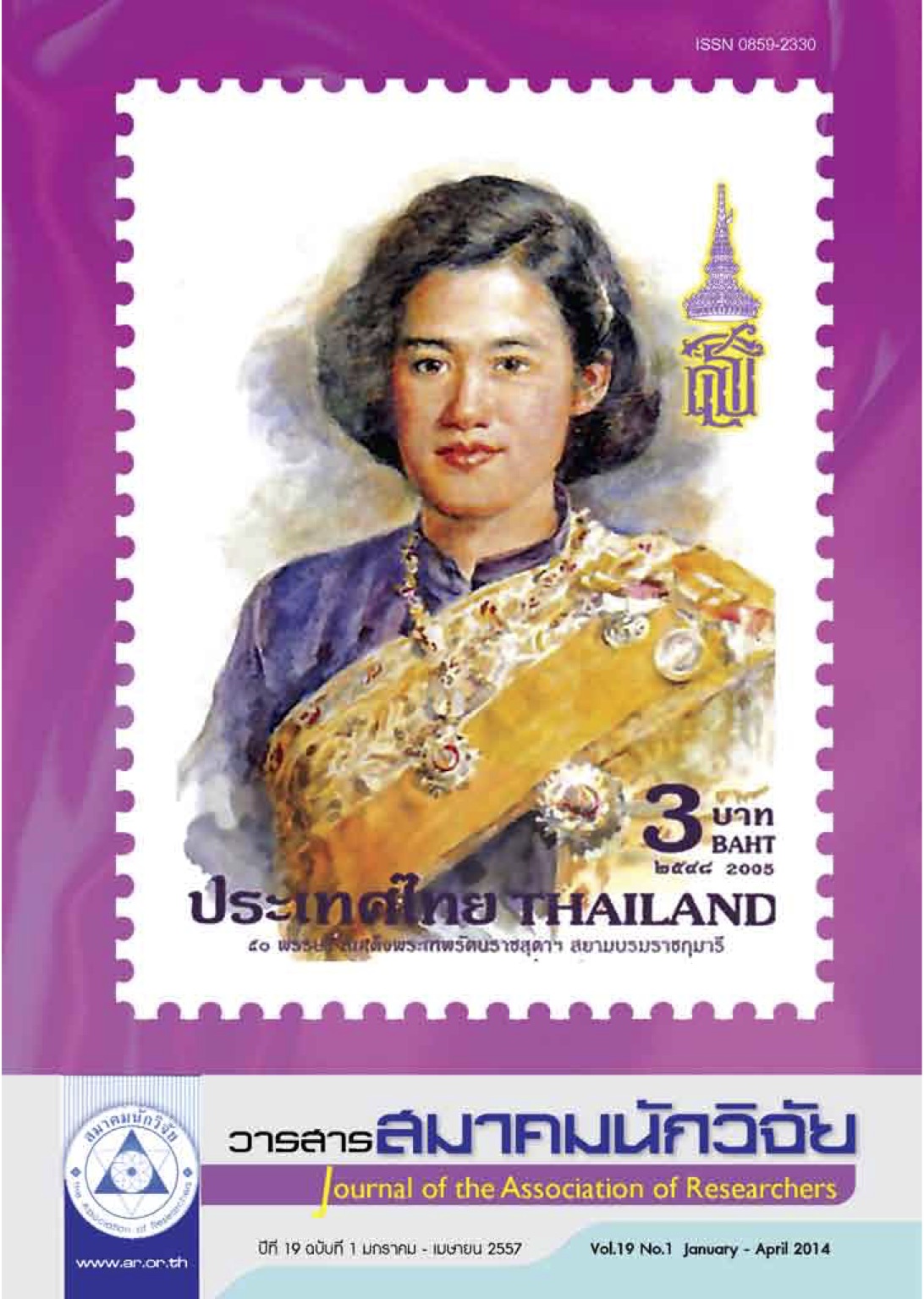คุณลักษณะภาวะผู้นำยุคใหม่กับสมรรถนะการบริหารงาน แบบมืออาชีพของปลัดเทศบาลในภาคกลาง
Main Article Content
บทคัดย่อ
การวิจัยครั้งนี้ เป็นแบบผสานวิธีทั้งเชิงปริมาณและเชิงคุณภาพ โดยการศึกษากลุ่มตัวอย่าง 535 คน ตาม ตารางของเครซีมอร์แกน โดยการสุ่มแบบหลายขั้นตอน ประกอบด้วยนายกเทศมนตรี จำนวน 60 คน และพนักงาน เทศบาลในเขตจังหวัดภาคกลาง 19 จังหวัด จำนวน 475 คน เครื่องมือที่ใช้ในการเก็บข้อมูล คือ แบบสอบถาม สถิติ ที่ใช้ในการวิเคราะห์ข้อมูล ได้แก่ ค่าร้อยละ ค่าเฉลี่ยส่วนเบี่ยงเบนมาตรฐานและทดสอบสมมติฐานด้วยการวิเคราะห์ การถดถอยพหุคูณ สำหรับการวิจัยเชิงคุณภาพ ใช้การสัมภาษณ์เชิงลึกกับผู้ให้ข้อมูลสำคัญ จำนวน 15 ราย โดยเลือก แบบเจาะจง จากผู้บริหารกระทรวงมหาดไทย กรมส่งเสริมการปกครองท้องถิ่น ผลการศึกษาพบว่า1). สมรรถนะการ บริหารงานแบบมืออาชีพของปลัดเทศบาลโดยรวมอยู่ในระดับมาก เมื่อพิจารณาเป็นรายด้านพบว่าคุณลักษณะสูงสุด คือ ด้านการแก้ไขปัญหาเฉพาะหน้า รองลงมา ได้แก่ ด้านการผลักดันการเปลี่ยนแปลง ด้านความมีวิสัยทัศน์กว้างไกล และด้านการบริหารแบบ มุ่งผลสัมฤทธิ์ตามลำดับ 2).ระดับความสัมพันธ์ระหว่างคุณลักษณะภาวะผู้นำยุคใหม่กับ สมรรถนะการบริหารงานแบบมืออาชีพของปลัดเทศบาลโดยรวมอยู่ในระดับมาก โดยคุณลักษณะภาวะผู้นำด้าน ความรับผิดชอบความฉลาดทางอารมณ์ การสร้างเครือข่าย การจัดการความสัมพันธ์ และทักษะการสื่อสารมีความ สัมพันธ์กับสมรรถนะการบริหารงานแบบมืออาชีพของปลัดเทศบาล อย่างมีนัยสำคัญทางสถิติที่ระดับ .01 โดย สามารถอธิบายสมรรถนะการบริหารงานโดยรวม ได้ร้อยละ 56.10 3).พบว่าความคิดเห็นของนายกเทศมนตรีโดย รวมอยู่ในระดับมาก คือ มีค่าเฉลี่ยเท่ากับ 2.70 และพนักงานเทศบาลมีค่าเฉลี่ยเท่ากับ2.69 ตามลำดับ จึงไม่มีความ แตกต่างกันทั้งโดยรวมและรายด้าน
Article Details
บทความที่ปรากฏในวารสารนี้ เป็นความรับผิดชอบของผู้เขียน ซึ่งสมาคมนักวิจัยไม่จำเป็นต้องเห็นด้วยเสมอไป การนำเสนอผลงานวิจัยและบทความในวารสารนี้ไปเผยแพร่สามารถกระทำได้ โดยระบุแหล่งอ้างอิงจาก "วารสารสมาคมนักวิจัย"
เอกสารอ้างอิง
ปรีชา สุวรรณภูมิ. (2554). รูปแบบการบริหารจัดการที่มีประสิทธิผลขององค์การบริหารส่วนตำบล ในกลุ่มจังหวัด ภาคเหนือตอนล่างกลุ่มที่ 1 ประเทศไทย. วารสารสมาคมนักวิจัย, 16(3), 102-117
รวิภา หอมเศรษฐี. (2549). สมรรถนะของผู้บริหารระดับกลางในระบบราชการไทย.วิทยานิพนธ์ปรัชญาดุษฎีบัณฑิต สาขาวิชารัฐประศาสนศาสตร์มหาวิทยาลัยรามคําแหง.
รรณา โชคบันดาลสุข และ รัชนิดา รอดอิ้ว. (2555). แนวทางการพัฒนาศักยภาพด้านคอมพิวเตอร์ของบุคลากร ในองค์การบริหารส่วนตำบลจังหวัดราชบุรี. วารสารสมาคมนักวิจัย, 17(2), 80-90
วาโร เพ็งสวัสดิ์. (2549). การพัฒนารูปแบบความสัมพันธ์โครงสร้างเชิงเส้นตรงของประสิทธิผลภาวะผู้นำของผู้ บริหารที่ส่งผลต่อประสิทธิผลของโรงเรียน. วิทยานิพนธ์ดุษฎีนิพนธ์ สาขาวิชาการบริหารการศึกษา มหาวิทยาลัยขอนแก่น.
สมคิด เลิศไพฑูรย์.(2548).กฎหมายรัฐธรรมนูญ : หลักการใหม่ตามรัฐธรรมนูญแห่งราชอาณาจักรไทยพุทธศักราช 2540.กรุงเทพฯ: มหาวิทยาลัยธรรมศาสตร์.
Blake, R. R. & Mouton, J. S.(1993).The managerial grid. Gulf Publishing, Houston.
Fiedler, F. E. (1958). Leader Attitudes and Group Effectiveness. Urbana, IL: University of Illinois Press.
_________(1967). A Theory of Leadership Effectiveness. New York: McGraw-Hill.
_________(1971). Leadership. New York: General Learning Press.
_________ (1981). Leader Attitudes and Group Effectiveness.Westport, CT: Greenwood Publishing Group.
_________(1992).Life in a Pretzel-shaped Universe.in A. G. Bedeian (ed.), Management.
Laureates: A Collection of Autobiographical Essays, Greenwich, CT: JAI Press,vol.1,301–34. Fiedler, F. E. (1994). Leadership Experience and Leadership Performance.Alexandria, VA: US Army Research Institute for the Behavioral and Social Sciences.
Fiedler, F. E. (1997). Directory of the American Psychological Association. Chicago: St James Press, 419.
House, R. J. & Mitchell, T. R. (1974). Path-goal theory of leadership.Contemporary Business 3. Fall. 81-98.


